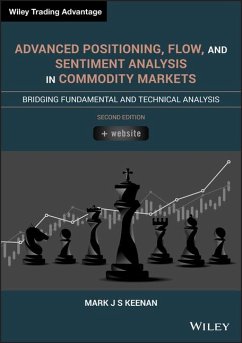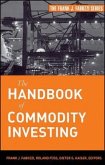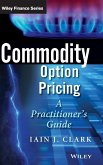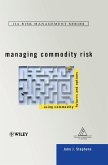Mark J S Keenan
Advanced Positioning, Flow, and Sentiment Analysis in Commodity Markets
Bridging Fundamental and Technical Analysis
Mark J S Keenan
Advanced Positioning, Flow, and Sentiment Analysis in Commodity Markets
Bridging Fundamental and Technical Analysis
- Gebundenes Buch
Andere Kunden interessierten sich auch für
![Advanced Commodity Spread Trading Advanced Commodity Spread Trading]() Harold GoldbergAdvanced Commodity Spread Trading55,99 €
Harold GoldbergAdvanced Commodity Spread Trading55,99 €![The Advanced Swing Trading Guide The Advanced Swing Trading Guide]() Neil SharpThe Advanced Swing Trading Guide20,99 €
Neil SharpThe Advanced Swing Trading Guide20,99 €![The Handbook of Commodity Investing The Handbook of Commodity Investing]() Frank J FabozziThe Handbook of Commodity Investing100,99 €
Frank J FabozziThe Handbook of Commodity Investing100,99 €![Commodity Option Pricing Commodity Option Pricing]() Iain J ClarkCommodity Option Pricing116,99 €
Iain J ClarkCommodity Option Pricing116,99 €![The Advanced Day Trader Guide The Advanced Day Trader Guide]() David HewittThe Advanced Day Trader Guide19,99 €
David HewittThe Advanced Day Trader Guide19,99 €![Advanced Fixed Income Analytics Advanced Fixed Income Analytics]() Wesley PhoaAdvanced Fixed Income Analytics159,99 €
Wesley PhoaAdvanced Fixed Income Analytics159,99 €![Managing Commodity Risk Managing Commodity Risk]() John J StephensManaging Commodity Risk145,99 €
John J StephensManaging Commodity Risk145,99 €-
-
-
Produktdetails
- Verlag: Wiley
- 2nd edition
- Seitenzahl: 288
- Erscheinungstermin: 18. Februar 2020
- Englisch
- Abmessung: 262mm x 189mm x 25mm
- Gewicht: 761g
- ISBN-13: 9781119603825
- ISBN-10: 111960382X
- Artikelnr.: 56970486
Hinweis: Dieser Artikel kann nur an eine deutsche Lieferadresse ausgeliefert werden.
- Herstellerkennzeichnung
- Libri GmbH
- Europaallee 1
- 36244 Bad Hersfeld
- 06621 890
MARK J S KEENAN is Managing Director, Global Commodities Strategist, and Head of Research for Asia-Pacific at Société Générale Corporate & Investment Bank (SG CIB) based in Singapore. He has over 20 years of research, trading and investment experience across all major commodity markets. Mark has worked in asset management, risk management and investment banking in both London and Singapore and developed a number of innovative trading, investment and risk management solutions for corporates, trade houses, investment institutions and hedge funds. He appears regularly on CNBC and Bloomberg television and is quoted widely in global press and media channels. He has a master's degree in Molecular and Cellular Biochemistry from Oxford University.
About the Author xi
Acknowledgements xiii
Preface xv
About the Companion Website xvii
Introduction 1
Chapter 1 Advanced Positioning, Flow, and Sentiment Analysis in Commodity
Markets 7
1.1 Positioning Analysis - What is It? 8
1.2 The History of Positioning Data, the COT Report, and the Agencies that
Provide the Data 10
1.3 Misunderstandings and Issues in Positioning Analysis 10
1.4 Futures and Options Data 17
Chapter 2 The Structure of the Positioning Data 19
2.1 The Structure of Positioning Data 20
2.2 Positioning Data for the London Metal Exchange (LME) - The MiFID
Classifications 28
2.3 Other Types of Positioning and Flow Data 33
2.4 The Structure of Commodity Markets 34
Chapter 3 Performance Attribution - An Insight into Sentiment and
Behavioural Analysis? 45
3.1 The Proliferation of Speculative Positioning Data 46
3.2 Why is Positioning Data Interesting 47
3.3 Measuring the Skill or Performance of MMs 48
3.4 Net Futures Positioning vs Net Trader Number Positioning or Alignment
55
Chapter 4 Concentration, Clustering, and Position Size - Price Risks and
Behavioural Patterns 59
4.1 Concentration, Clustering, and Position Size 60
4.2 Concentration, Clustering, Position Size, and Their Relationship to
Price Over Time 62
Chapter 5 'Dry Powder (DP)' Analysis - An Alternative Way to Visualise
Positioning 71
5.1 Dry Powder (DP) Analysis 72
5.2 DP Indicator Variations 75
5.3 DP Indicators and Trading Signals 82
Chapter 6 Advanced DP Analysis - Deeper Insights and More Variables 87
6.1 Advanced DP Indicator Charts 88
6.2 DP Indicators, Price, and Curve Structure 96
6.3 DP Hedging Indicators 99
6.4 DP Factor, Fundamental, and Currency Indicators 101
Chapter 7 Decomposing Trading Flow and Quantifying Position Dynamics 111
7.1 Decomposing Net Positioning - The Methodology 112
7.2 Decomposing Long and Short Positioning - The Methodology 115
7.3 Who Has Been Driving Prices? 116
7.4 Who is Trading with Whom? 118
7.5 The Impact on Prices 122
7.6 Speed of Positioning Changes 124
Chapter 8 Overbought/Oversold (OBOS) Analysis - The Intersection of
Extremes 127
8.1 The Overbought/Oversold (OBOS) Philosophy 128
8.2 Constructing the Framework 128
8.3 The OBOS Concentration Indicator 132
8.4 Key Attributes of the OBOS Approach 133
8.5 Behavioural Patterns within the Boxes 134
8.6 OBOS Variations 138
8.7 The DP/OBOS Hybrid Indicator 141
Chapter 9 Advanced OBOS Analysis - Extremes in Sentiment and Risk 147
9.1 The OBOS Framework - Clustering and Position Sizes 147
9.2 OBOS Factor Indicators 155
9.3 Commodity Risk Premia - Positioning Analysis and Risk Management 159
Chapter 10 Sentiment Analysis - Sentiment Indices and Positioning
Mismatches 163
10.1 The Difference between Trader Numbers and Open Interest 164
10.2 Trader Sentiment (TS) Indices 166
10.3 Mismatches in Positioning and Price Inflexion Points 172
Chapter 11 Newsflow in Positioning Analysis 177
11.1 Newsflow Data in Commodity Markets 178
11.2 Building Basic Newsflow Indices 181
11.3 Combining Newsflow with Positioning 186
11.4 Economic Policy Uncertainty 190
Chapter 12 Flow Analysis - The 'Flow Cube' and the 'Build Ratio' in
Commodity Markets 191
12.1 The Flow Cube 192
12.2 The Flow Cube down the Forward Curve 198
12.3 The LBMA-i Trade Data 202
Chapter 13 Chinese Commodity Markets - Analysing Flow 203
13.1 The Chinese Commodity Exchanges 203
13.2 The Size of the Chinese Commodity Exchanges 205
13.3 Speculative vs Hedging Activity in Chinese Commodities 208
13.4 The Flow Cube and Build Ratio in Chinese Commodities 210
13.5 The OBOS Framework and the Speculation Ratio 212
Chapter 14 Machine Learning - A Machine's Perspective on Positioning 215
14.1 Introduction to Machine Learning (ML) 216
14.2 Decision Trees 217
14.3 Feature Importance 227
14.4 Random Forests 229
14.5 Using ML to Trade 232
Appendix 1 History of the COT Report 235
Appendix 2 The COT Reports 237
Index 249
Acknowledgements xiii
Preface xv
About the Companion Website xvii
Introduction 1
Chapter 1 Advanced Positioning, Flow, and Sentiment Analysis in Commodity
Markets 7
1.1 Positioning Analysis - What is It? 8
1.2 The History of Positioning Data, the COT Report, and the Agencies that
Provide the Data 10
1.3 Misunderstandings and Issues in Positioning Analysis 10
1.4 Futures and Options Data 17
Chapter 2 The Structure of the Positioning Data 19
2.1 The Structure of Positioning Data 20
2.2 Positioning Data for the London Metal Exchange (LME) - The MiFID
Classifications 28
2.3 Other Types of Positioning and Flow Data 33
2.4 The Structure of Commodity Markets 34
Chapter 3 Performance Attribution - An Insight into Sentiment and
Behavioural Analysis? 45
3.1 The Proliferation of Speculative Positioning Data 46
3.2 Why is Positioning Data Interesting 47
3.3 Measuring the Skill or Performance of MMs 48
3.4 Net Futures Positioning vs Net Trader Number Positioning or Alignment
55
Chapter 4 Concentration, Clustering, and Position Size - Price Risks and
Behavioural Patterns 59
4.1 Concentration, Clustering, and Position Size 60
4.2 Concentration, Clustering, Position Size, and Their Relationship to
Price Over Time 62
Chapter 5 'Dry Powder (DP)' Analysis - An Alternative Way to Visualise
Positioning 71
5.1 Dry Powder (DP) Analysis 72
5.2 DP Indicator Variations 75
5.3 DP Indicators and Trading Signals 82
Chapter 6 Advanced DP Analysis - Deeper Insights and More Variables 87
6.1 Advanced DP Indicator Charts 88
6.2 DP Indicators, Price, and Curve Structure 96
6.3 DP Hedging Indicators 99
6.4 DP Factor, Fundamental, and Currency Indicators 101
Chapter 7 Decomposing Trading Flow and Quantifying Position Dynamics 111
7.1 Decomposing Net Positioning - The Methodology 112
7.2 Decomposing Long and Short Positioning - The Methodology 115
7.3 Who Has Been Driving Prices? 116
7.4 Who is Trading with Whom? 118
7.5 The Impact on Prices 122
7.6 Speed of Positioning Changes 124
Chapter 8 Overbought/Oversold (OBOS) Analysis - The Intersection of
Extremes 127
8.1 The Overbought/Oversold (OBOS) Philosophy 128
8.2 Constructing the Framework 128
8.3 The OBOS Concentration Indicator 132
8.4 Key Attributes of the OBOS Approach 133
8.5 Behavioural Patterns within the Boxes 134
8.6 OBOS Variations 138
8.7 The DP/OBOS Hybrid Indicator 141
Chapter 9 Advanced OBOS Analysis - Extremes in Sentiment and Risk 147
9.1 The OBOS Framework - Clustering and Position Sizes 147
9.2 OBOS Factor Indicators 155
9.3 Commodity Risk Premia - Positioning Analysis and Risk Management 159
Chapter 10 Sentiment Analysis - Sentiment Indices and Positioning
Mismatches 163
10.1 The Difference between Trader Numbers and Open Interest 164
10.2 Trader Sentiment (TS) Indices 166
10.3 Mismatches in Positioning and Price Inflexion Points 172
Chapter 11 Newsflow in Positioning Analysis 177
11.1 Newsflow Data in Commodity Markets 178
11.2 Building Basic Newsflow Indices 181
11.3 Combining Newsflow with Positioning 186
11.4 Economic Policy Uncertainty 190
Chapter 12 Flow Analysis - The 'Flow Cube' and the 'Build Ratio' in
Commodity Markets 191
12.1 The Flow Cube 192
12.2 The Flow Cube down the Forward Curve 198
12.3 The LBMA-i Trade Data 202
Chapter 13 Chinese Commodity Markets - Analysing Flow 203
13.1 The Chinese Commodity Exchanges 203
13.2 The Size of the Chinese Commodity Exchanges 205
13.3 Speculative vs Hedging Activity in Chinese Commodities 208
13.4 The Flow Cube and Build Ratio in Chinese Commodities 210
13.5 The OBOS Framework and the Speculation Ratio 212
Chapter 14 Machine Learning - A Machine's Perspective on Positioning 215
14.1 Introduction to Machine Learning (ML) 216
14.2 Decision Trees 217
14.3 Feature Importance 227
14.4 Random Forests 229
14.5 Using ML to Trade 232
Appendix 1 History of the COT Report 235
Appendix 2 The COT Reports 237
Index 249
About the Author xi
Acknowledgements xiii
Preface xv
About the Companion Website xvii
Introduction 1
Chapter 1 Advanced Positioning, Flow, and Sentiment Analysis in Commodity
Markets 7
1.1 Positioning Analysis - What is It? 8
1.2 The History of Positioning Data, the COT Report, and the Agencies that
Provide the Data 10
1.3 Misunderstandings and Issues in Positioning Analysis 10
1.4 Futures and Options Data 17
Chapter 2 The Structure of the Positioning Data 19
2.1 The Structure of Positioning Data 20
2.2 Positioning Data for the London Metal Exchange (LME) - The MiFID
Classifications 28
2.3 Other Types of Positioning and Flow Data 33
2.4 The Structure of Commodity Markets 34
Chapter 3 Performance Attribution - An Insight into Sentiment and
Behavioural Analysis? 45
3.1 The Proliferation of Speculative Positioning Data 46
3.2 Why is Positioning Data Interesting 47
3.3 Measuring the Skill or Performance of MMs 48
3.4 Net Futures Positioning vs Net Trader Number Positioning or Alignment
55
Chapter 4 Concentration, Clustering, and Position Size - Price Risks and
Behavioural Patterns 59
4.1 Concentration, Clustering, and Position Size 60
4.2 Concentration, Clustering, Position Size, and Their Relationship to
Price Over Time 62
Chapter 5 'Dry Powder (DP)' Analysis - An Alternative Way to Visualise
Positioning 71
5.1 Dry Powder (DP) Analysis 72
5.2 DP Indicator Variations 75
5.3 DP Indicators and Trading Signals 82
Chapter 6 Advanced DP Analysis - Deeper Insights and More Variables 87
6.1 Advanced DP Indicator Charts 88
6.2 DP Indicators, Price, and Curve Structure 96
6.3 DP Hedging Indicators 99
6.4 DP Factor, Fundamental, and Currency Indicators 101
Chapter 7 Decomposing Trading Flow and Quantifying Position Dynamics 111
7.1 Decomposing Net Positioning - The Methodology 112
7.2 Decomposing Long and Short Positioning - The Methodology 115
7.3 Who Has Been Driving Prices? 116
7.4 Who is Trading with Whom? 118
7.5 The Impact on Prices 122
7.6 Speed of Positioning Changes 124
Chapter 8 Overbought/Oversold (OBOS) Analysis - The Intersection of
Extremes 127
8.1 The Overbought/Oversold (OBOS) Philosophy 128
8.2 Constructing the Framework 128
8.3 The OBOS Concentration Indicator 132
8.4 Key Attributes of the OBOS Approach 133
8.5 Behavioural Patterns within the Boxes 134
8.6 OBOS Variations 138
8.7 The DP/OBOS Hybrid Indicator 141
Chapter 9 Advanced OBOS Analysis - Extremes in Sentiment and Risk 147
9.1 The OBOS Framework - Clustering and Position Sizes 147
9.2 OBOS Factor Indicators 155
9.3 Commodity Risk Premia - Positioning Analysis and Risk Management 159
Chapter 10 Sentiment Analysis - Sentiment Indices and Positioning
Mismatches 163
10.1 The Difference between Trader Numbers and Open Interest 164
10.2 Trader Sentiment (TS) Indices 166
10.3 Mismatches in Positioning and Price Inflexion Points 172
Chapter 11 Newsflow in Positioning Analysis 177
11.1 Newsflow Data in Commodity Markets 178
11.2 Building Basic Newsflow Indices 181
11.3 Combining Newsflow with Positioning 186
11.4 Economic Policy Uncertainty 190
Chapter 12 Flow Analysis - The 'Flow Cube' and the 'Build Ratio' in
Commodity Markets 191
12.1 The Flow Cube 192
12.2 The Flow Cube down the Forward Curve 198
12.3 The LBMA-i Trade Data 202
Chapter 13 Chinese Commodity Markets - Analysing Flow 203
13.1 The Chinese Commodity Exchanges 203
13.2 The Size of the Chinese Commodity Exchanges 205
13.3 Speculative vs Hedging Activity in Chinese Commodities 208
13.4 The Flow Cube and Build Ratio in Chinese Commodities 210
13.5 The OBOS Framework and the Speculation Ratio 212
Chapter 14 Machine Learning - A Machine's Perspective on Positioning 215
14.1 Introduction to Machine Learning (ML) 216
14.2 Decision Trees 217
14.3 Feature Importance 227
14.4 Random Forests 229
14.5 Using ML to Trade 232
Appendix 1 History of the COT Report 235
Appendix 2 The COT Reports 237
Index 249
Acknowledgements xiii
Preface xv
About the Companion Website xvii
Introduction 1
Chapter 1 Advanced Positioning, Flow, and Sentiment Analysis in Commodity
Markets 7
1.1 Positioning Analysis - What is It? 8
1.2 The History of Positioning Data, the COT Report, and the Agencies that
Provide the Data 10
1.3 Misunderstandings and Issues in Positioning Analysis 10
1.4 Futures and Options Data 17
Chapter 2 The Structure of the Positioning Data 19
2.1 The Structure of Positioning Data 20
2.2 Positioning Data for the London Metal Exchange (LME) - The MiFID
Classifications 28
2.3 Other Types of Positioning and Flow Data 33
2.4 The Structure of Commodity Markets 34
Chapter 3 Performance Attribution - An Insight into Sentiment and
Behavioural Analysis? 45
3.1 The Proliferation of Speculative Positioning Data 46
3.2 Why is Positioning Data Interesting 47
3.3 Measuring the Skill or Performance of MMs 48
3.4 Net Futures Positioning vs Net Trader Number Positioning or Alignment
55
Chapter 4 Concentration, Clustering, and Position Size - Price Risks and
Behavioural Patterns 59
4.1 Concentration, Clustering, and Position Size 60
4.2 Concentration, Clustering, Position Size, and Their Relationship to
Price Over Time 62
Chapter 5 'Dry Powder (DP)' Analysis - An Alternative Way to Visualise
Positioning 71
5.1 Dry Powder (DP) Analysis 72
5.2 DP Indicator Variations 75
5.3 DP Indicators and Trading Signals 82
Chapter 6 Advanced DP Analysis - Deeper Insights and More Variables 87
6.1 Advanced DP Indicator Charts 88
6.2 DP Indicators, Price, and Curve Structure 96
6.3 DP Hedging Indicators 99
6.4 DP Factor, Fundamental, and Currency Indicators 101
Chapter 7 Decomposing Trading Flow and Quantifying Position Dynamics 111
7.1 Decomposing Net Positioning - The Methodology 112
7.2 Decomposing Long and Short Positioning - The Methodology 115
7.3 Who Has Been Driving Prices? 116
7.4 Who is Trading with Whom? 118
7.5 The Impact on Prices 122
7.6 Speed of Positioning Changes 124
Chapter 8 Overbought/Oversold (OBOS) Analysis - The Intersection of
Extremes 127
8.1 The Overbought/Oversold (OBOS) Philosophy 128
8.2 Constructing the Framework 128
8.3 The OBOS Concentration Indicator 132
8.4 Key Attributes of the OBOS Approach 133
8.5 Behavioural Patterns within the Boxes 134
8.6 OBOS Variations 138
8.7 The DP/OBOS Hybrid Indicator 141
Chapter 9 Advanced OBOS Analysis - Extremes in Sentiment and Risk 147
9.1 The OBOS Framework - Clustering and Position Sizes 147
9.2 OBOS Factor Indicators 155
9.3 Commodity Risk Premia - Positioning Analysis and Risk Management 159
Chapter 10 Sentiment Analysis - Sentiment Indices and Positioning
Mismatches 163
10.1 The Difference between Trader Numbers and Open Interest 164
10.2 Trader Sentiment (TS) Indices 166
10.3 Mismatches in Positioning and Price Inflexion Points 172
Chapter 11 Newsflow in Positioning Analysis 177
11.1 Newsflow Data in Commodity Markets 178
11.2 Building Basic Newsflow Indices 181
11.3 Combining Newsflow with Positioning 186
11.4 Economic Policy Uncertainty 190
Chapter 12 Flow Analysis - The 'Flow Cube' and the 'Build Ratio' in
Commodity Markets 191
12.1 The Flow Cube 192
12.2 The Flow Cube down the Forward Curve 198
12.3 The LBMA-i Trade Data 202
Chapter 13 Chinese Commodity Markets - Analysing Flow 203
13.1 The Chinese Commodity Exchanges 203
13.2 The Size of the Chinese Commodity Exchanges 205
13.3 Speculative vs Hedging Activity in Chinese Commodities 208
13.4 The Flow Cube and Build Ratio in Chinese Commodities 210
13.5 The OBOS Framework and the Speculation Ratio 212
Chapter 14 Machine Learning - A Machine's Perspective on Positioning 215
14.1 Introduction to Machine Learning (ML) 216
14.2 Decision Trees 217
14.3 Feature Importance 227
14.4 Random Forests 229
14.5 Using ML to Trade 232
Appendix 1 History of the COT Report 235
Appendix 2 The COT Reports 237
Index 249








